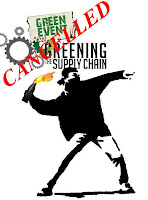
Sustainable supply chains are an integral part of a rapidly growing trend that is transforming businesses around the world. Supply chains are critical links that connect an organisation’s inputs to its outputs. The increasing environmental costs of these networks and growing consumer pressure for eco-friendly products has led many organisations to look at supply chain sustainability as a new measure of profitable logistics management.
Approximately 70 percent of all surveyed top executives consider sustainability efforts essential to long-term profitability. For firms' purchasing strategies, purchasing heads rank environmental efforts as most important among sustainability initiatives.
In response to overwhelming demand for sustainable supply chain expertise, educational facilities like the W. P. Carey School of Business at Arizona State University are building green supply chains into their curriculums.
The level of an organizations involvement can be catagorized into one of three general groups sometimes referred to as the
three tiers of sustainability.
Tier 1) The Basics: This is the base level where companies employ simple measures such as switching lights and PCs off when left idle, recycling paper, and using greener forms of travel with the purpose of reducing the day-to-day carbon footprint. Some companies also employ self-service technologies such as centralised procurement and teleconferencing.
Tier 2) Thinking Sustainably: This is the second level, where companies begin to realise the need to embed sustainability into supply chain operations. Companies tend to achieve this level when they assess their impact across a local range of operations. In terms of the supply chain, this could involve supplier management, product design, manufacturing rationalisation, and distribution optimisation.
Tier 3) The Science of Sustainability: The third tier of supply chain sustainability uses detailed auditing and benchmarks to provide a framework for governing sustainable supply chain operations. This clarifies the environmental impact of adjustments to supply chain agility, flexibility, and cost in the supply chain network. Moving towards this level means being driven by the current climate as well as pushing emerging regulations and standards at both an industry and governmental level.
An October 2009 GTM report, titled
Greening the Supply Chain: Benchmarking Sustainability Practices and Trends, indicates that green supply chain leaders are benefiting from reduced costs, increased revenue and recognition.
The report includes case studies and interviews with supply chain executives and sustainability officers. Although energy reduction in the supply chain has received a lot of attention, there are other efforts including more efficient product designs.
According to David Schatsky, one of the report's authors, "The supply chain represents a big opportunity for firms to realize the financial, operational and strategic benefits of sustainable business practices."
Despite its growing prominence, sustainability is not at the core of most companies’ strategic planning and although involvement is increasing, it is not yet the prime driver of supply chain agendas.
While there are many benefits to greening the supply chain, there are also impediments. Many companies cannot fully evaluate their suppliers and customers, making it difficult to assess the true environmental costs. However, as the basic standards of sustainability reporting become increasingly common it will be easier to make more accurate assessments.
Sustainable supply chain efforts are a defining feature of a serious environmental commitment. Overall, the research indicates that sustainability offers major competitive advantages, especially with regard to production efficiency, supplier management skills and employee morale.
___________________________________
Related PostsWalmart and HP's Sustainable Supply ChainsPuma's Sustainable Supply ChainIT Sector Should Leverage Their Supply ChainsGreen DriversBest Practices for Communicating SustainabilityBest Practices for Engaging Employees in SustainabilityBest Practices for Sustainable Businesses
Midwest Best Practices Conference for Sustainable CommunitiesInnovation and the Development of Sustainable Products or ProcessesAn Integrative Approach to Eco-Innovation10 Steps to Sustainability-Driven InnovationSustainability is a Catalyst for InnovationSustainable Brands 2010Sustainable Brands Innovation Open FinalistsSustainable Successes and FailuresSustainable Business Methods, Strategy, Management and ReportingSustainability is an Unstoppable MegatrendThe Overwhelming Logic of Sustainable BusinessClimate Counts: Businesses Combating Climate ChangeSocial Action Driving Businesses to Adopt Sustainable PracticesConsumers Continue to Embrace the Burgeoning Green MarketThe 2010 World Energy Technologies SummitEnvironmental Revolution: Technology CertificationEnvironmental Revolution: Building and OperationsEnvironmental Revolution: Leadership and Morale
 Canada has the dubious distinction of being one the world's leading greenhouse gas (GHG) emitting nations.
Canada has the dubious distinction of being one the world's leading greenhouse gas (GHG) emitting nations.













